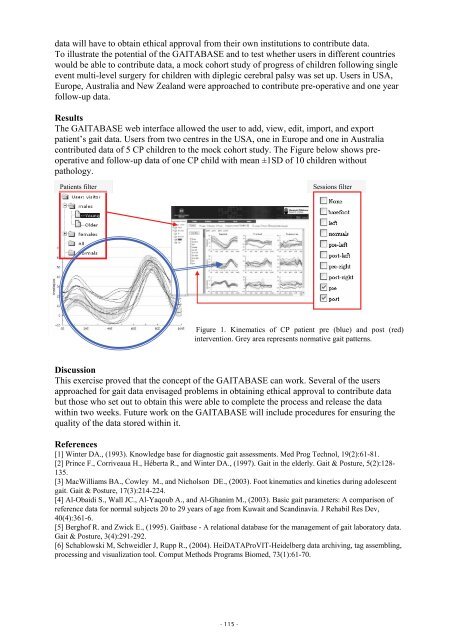1st Joint ESMAC-GCMAS Meeting - Análise de Marcha
1st Joint ESMAC-GCMAS Meeting - Análise de Marcha
1st Joint ESMAC-GCMAS Meeting - Análise de Marcha
Create successful ePaper yourself
Turn your PDF publications into a flip-book with our unique Google optimized e-Paper software.
data will have to obtain ethical approval from their own institutions to contribute data.<br />
To illustrate the potential of the GAITABASE and to test whether users in different countries<br />
would be able to contribute data, a mock cohort study of progress of children following single<br />
event multi-level surgery for children with diplegic cerebral palsy was set up. Users in USA,<br />
Europe, Australia and New Zealand were approached to contribute pre-operative and one year<br />
follow-up data.<br />
Results<br />
The GAITABASE web interface allowed the user to add, view, edit, import, and export<br />
patient’s gait data. Users from two centres in the USA, one in Europe and one in Australia<br />
contributed data of 5 CP children to the mock cohort study. The Figure below shows preoperative<br />
and follow-up data of one CP child with mean ±1SD of 10 children without<br />
pathology.<br />
Patients filter<br />
- 115 -<br />
Sessions filter<br />
Figure 1. Kinematics of CP patient pre (blue) and post (red)<br />
intervention. Grey area represents normative gait patterns.<br />
Discussion<br />
This exercise proved that the concept of the GAITABASE can work. Several of the users<br />
approached for gait data envisaged problems in obtaining ethical approval to contribute data<br />
but those who set out to obtain this were able to complete the process and release the data<br />
within two weeks. Future work on the GAITABASE will inclu<strong>de</strong> procedures for ensuring the<br />
quality of the data stored within it.<br />
References<br />
[1] Winter DA., (1993). Knowledge base for diagnostic gait assessments. Med Prog Technol, 19(2):61-81.<br />
[2] Prince F., Corriveaua H., Héberta R., and Winter DA., (1997). Gait in the el<strong>de</strong>rly. Gait & Posture, 5(2):128-<br />
135.<br />
[3] MacWilliams BA., Cowley M., and Nicholson DE., (2003). Foot kinematics and kinetics during adolescent<br />
gait. Gait & Posture, 17(3):214-224.<br />
[4] Al-Obaidi S., Wall JC., Al-Yaqoub A., and Al-Ghanim M., (2003). Basic gait parameters: A comparison of<br />
reference data for normal subjects 20 to 29 years of age from Kuwait and Scandinavia. J Rehabil Res Dev,<br />
40(4):361-6.<br />
[5] Berghof R. and Zwick E., (1995). Gaitbase - A relational database for the management of gait laboratory data.<br />
Gait & Posture, 3(4):291-292.<br />
[6] Schablowski M, Schweidler J, Rupp R., (2004). HeiDATAProVIT-Hei<strong>de</strong>lberg data archiving, tag assembling,<br />
processing and visualization tool. Comput Methods Programs Biomed, 73(1):61-70.
















